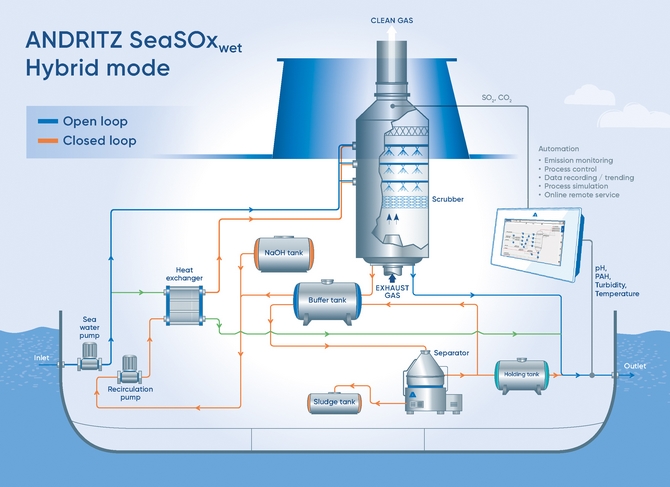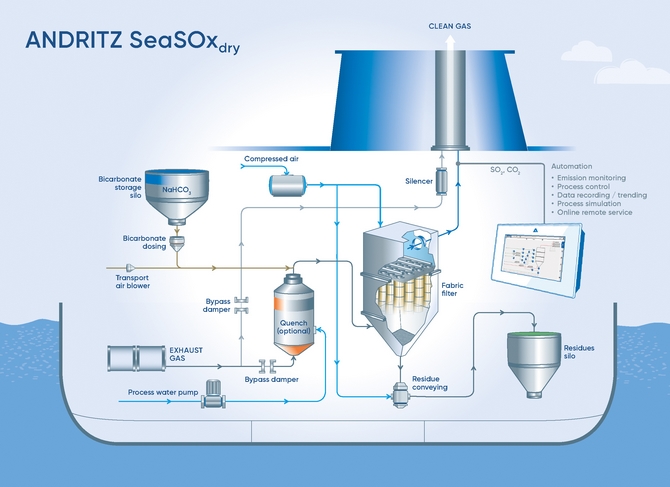
Scrubbers for the maritime industry
The ANDRITZ GROUP at a glance
ANDRITZ is a globally leading supplier of plants, equipment, and services for hydropower stations, the pulp and paper industry, the metalworking and steel industries, and for solid/liquid separation in the municipal and industrial sectors as well as for animal feed and biomass pelleting.
The publicly listed technology Group is headquartered in Graz, Austria, and has a staff of approximately 29,000 employees. ANDRITZ operates more than 280 sites in over 40 countries.
ANDRITZ has developed the SeaSOx technology, which is the right solution to clean exhaust gas in order to meet the new requirements. It can be installed on all types of ships, either on a new build or retrofit basis, thanks to its flexibility and it is available in I-Type and U-Type versions. Designed on the basis of more than 35 years of experience in scrubber design and using the most highly developed CFD models to simulate and optimize flow distribution and SOx mass transfer.
ANDRITZ SeaSOx wet technology
Wet desulphurization process
OPEN LOOP MODE
In open loop mode, seawater is used as a washing medium to clean the exhaust gas.  This simple process makes use of the natural alkalinity of the seawater in chemical absorption of the SOx. For this reason, the washing medium is pumped from sea chests to the absorber, where the absorption process takes place by means of spray scrubbing. The treated exhaust gas can then be released to the environment, and the effluent is also discharged. Both the exhaust gas and the effluent have to meet several critical, environmental constraints, which are validated by continuous emission monitoring.
This simple process makes use of the natural alkalinity of the seawater in chemical absorption of the SOx. For this reason, the washing medium is pumped from sea chests to the absorber, where the absorption process takes place by means of spray scrubbing. The treated exhaust gas can then be released to the environment, and the effluent is also discharged. Both the exhaust gas and the effluent have to meet several critical, environmental constraints, which are validated by continuous emission monitoring.
CLOSED LOOP MODE
If the natural alkalinity is too low or discharging of effluent is not allowed, SOx scrubbing is performed in closed loop mode. In this mode, the washing medium is recycled, and a neutralizing agent (50% wt. NaOH, Na2CO3) is added in metered doses to obtain a certain absorption capacity. In order to control the absorption temperature and maintain the water balance, an inline heat exchanger is provided on request to cool the washing medium down. Consequently, the effluent has to be cleaned periodically depending on the engine load, the ship’s route, and its fuel specification. For this application, a washing water treatment unit is installed to separate the particles and salts from the washing medium, in accordance with the MARPOL Convention, before it is discharged into the sea. The sludge generated
is collected in a separate tank, while the treated washing water is either stored in the holding tank or
discharged into the sea, depending on local discharging restrictions.
HYBRID MODE
A combination of open and closed loop operations is called hybrid mode. In hybrid mode, it is possible to switch between these two processes depending on the predominant basic conditions (seawater alkalinity, discharge restrictions, etc.). This option provides high flexibility and enables customers to choose the best process, both economically and technically.
ANDRITZ SeaSOx dry technology
Dry desulphurization process
In the dry desulphurization process, sodium bicarbonate (NaHCO3)  is injected as a dry powder into the existing exhaust pipe. Due to the prevailing high temperature and adequate residence time, the NaHCO3 particle is activated, which increases the reactive surface by many times. This activation is necessary for the NaHCO3 to react with the sulfur components. Such a process requires a temperature of at least 150°C. If the temperature of the exhaust gas stream from the engines is higher than 250°C, a quench is connected upstream, which brings the exhaust gas to the desired temperature by means of evaporative cooling.
is injected as a dry powder into the existing exhaust pipe. Due to the prevailing high temperature and adequate residence time, the NaHCO3 particle is activated, which increases the reactive surface by many times. This activation is necessary for the NaHCO3 to react with the sulfur components. Such a process requires a temperature of at least 150°C. If the temperature of the exhaust gas stream from the engines is higher than 250°C, a quench is connected upstream, which brings the exhaust gas to the desired temperature by means of evaporative cooling.
At the downstream dust filter, on which other particles (e.g. dust, soot …) are also deposited in addition to the sodium bicarbonate, a filter cake builds up on the filter cloth, and this is where the decisive chemical reaction takes place. SO2 reacts with NaHCO3 to form Na2SO4, which is also present as a powder. After a defined period of time or due to the maximum allowed pressure loss, the dust filter is cleaned by means of a pulse-jet process. During operation, a short stream of air is introduced at high pressure into the bag filter, whereby the filter cake peels off and drops into a collecting funnel. From there, the product is carried off by compressed air and stored in a silo.
Clean air is the basis for a healthy life!
